Meet Dr. Fernando Camino: Staff Scientist, CFN, Brookhaven National Lab
December 10, 2019
The following story was originally published by Nanotech NYC.
Nanotech NYC sits down with students, faculty and researchers from across the greater NYC area to give those interested a glimpse into the local nanotechnology scene. Today we sit down with Dr. Fernando Camino, a Staff Scientist at Center for Functional Nanomaterials (CFN), Brookhaven National Lab.
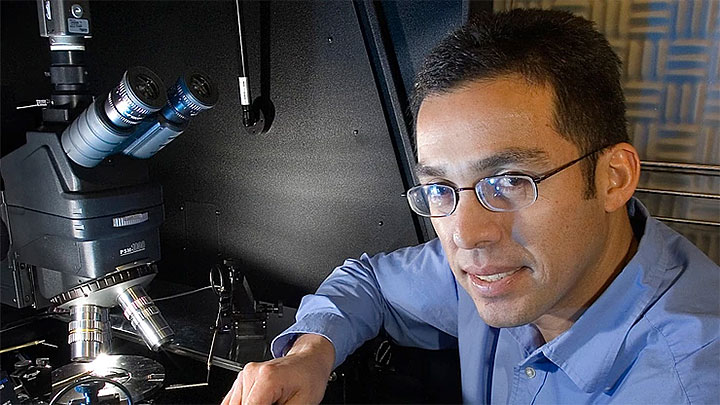
Dr. Fernando Camino, Staff Scientist, Center for Functional Nanomaterials, Brookhaven National Lab
Tell us a little bit about where you are from.
I am from Lima, Peru. I spent a lot of time near the ocean, which I like so much. I think that is why I feel very comfortable living in Long Island. However, this was not planned at all!
Tell us about your professional journey so far.
I received my B.S and Licentiate degrees in physics from the National Engineering University in Lima, Peru, and my Ph.D. degree in physics from Stony Brook University. My Ph.D. work centered in electronic transport in semiconductor heterostructures. I also worked at Stony Brook University as a Postdoctoral Research Associate and Research Scientist fabricating and studying quantum interferometers that work in the integer and fractional quantum Hall regimes. In 2007, I joined the scientific staff of the Center for Functional Nanomaterials (CFN) at Brookhaven National Laboratory (BNL) where I work until now.
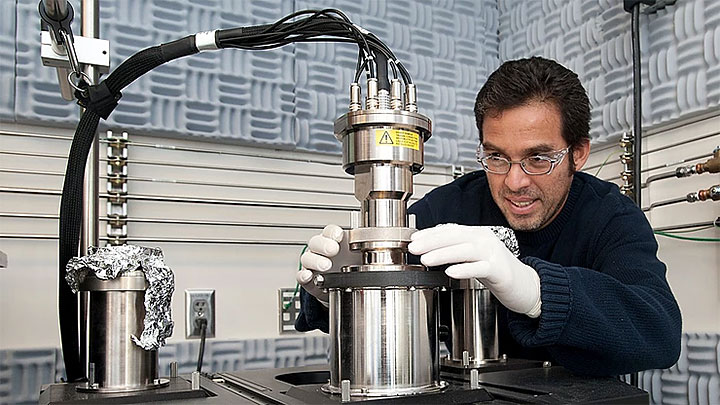
Dr. Camino setting up equipment located in the Electrical Characterization Facility which is used in electronic transport studies of materials.
What facilities are you leading now and what is the group’s overall focus? Can you tell us about some potential applications for your work?
I oversee several instruments in several facilities at the CFN. In the Electrical Characterization Facility, I use instruments that allow electronic transport studies at variable temperature (from 4K to 800 K) and magnetic fields (up to 3 Tesla). In the Nanofabrication Facility, I supervise the operation of a dual-beam (electron and ion) microscope, which we like to refer as our nanoscale Swiss Army knife, since it possesses multiple nanofabrication capabilities, such as nanoscale milling of practically any material, patterning of structures via beam-assisted deposition and sample micromanipulation. I also supervise the use of a low-energy transmission electron microscope (TEM) and a low-temperature TEM holder, which is one of a handful of holders in the world that can achieve temperatures as low as 12 K.
What Is the next big project you are planning to undertake?
I love the challenge of making novel devices, which usually requires the development of non-conventional nanofabrication techniques. Recently, CFN scientist achieved one nanometer scale electron-beam lithography, which we used to modify the geometry of Si nanopillars to tune their plasmonic response. I find this capability fascinating! I would like to use it to modify the geometry of atomically thin 2D materials (graphene, transition metal dichalcogenides, etc.), which already have special properties thanks to their intrinsic reduced dimensions.
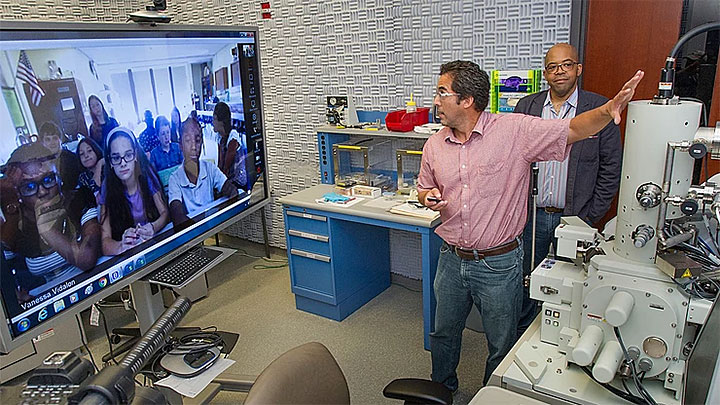
Dr. Camino remotely teaching a group of school middle school children about an electron microscope used to characterize materials and devices.
Do you collaborate with groups in Greater NYC area? How is it complimentary and important to your work?
I do collaborate, and it is a big component of my work. The CFN is a user facility with a dual mission of performing world-class in-house science and offering our user community access to state-of-art instrumentation and staff expertise. For example, Prof. Fang Li from New York Institute of Technology uses our Electrical Characterization Facility to test microwave pressure sensors that work at cryogenic temperatures.
Tell us about your role in the outreach programs for CFN (High school programs, summer Sundays, others). What was some rewarding/difficult experiences?
I have organized and participated in several outreach activities during my time in the CFN. I am always thrilled by the enthusiasm for science that boys and particularly girls show during these events. I especially like to interact with middle school kids, since they are at an age in which their enthusiasm is complemented with deeper understanding, making them even more interested in science. A good challenge for everyone is to maintain the kids’ interest in science through their high-school years (what a challenge!) so they can use it to succeed in college and graduate school. BNL supports and encourages outreach projects with local schools. The best way to learn about the many of outreach activities at BNL is to contact a staff at the Office of Educational Programs (https://www.bnl.gov/education/staff.php).
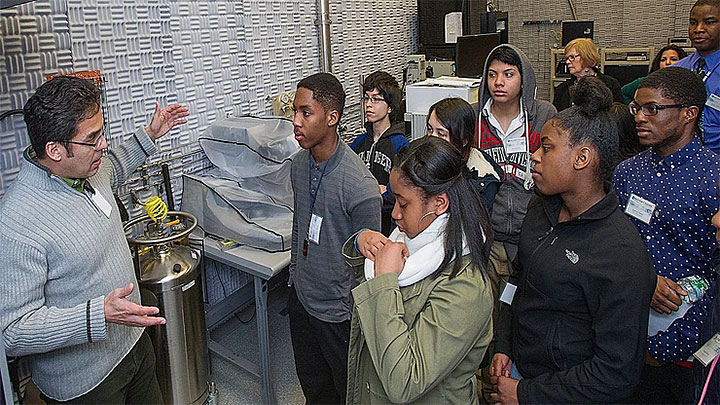
Dr. Camino giving a tour to a group of high school students who are visiting the BNL Center for Functional Nanomaterials.
What do you do for fun outside of your work?
I have lots of fun sitting at coffee shops with my younger daughter and practicing math problems. We just do it for 20-30 mins, the rest of the time we separately read, draw or check the web. I need to bribe her with good snacks and drinks, but the reward for me is immense when I see the emotion in her face when she solves a problem by herself. I notice that this gives her a lot of confidence and hopefully will help her in the future. My older daughter also had many snacks at the coffee shop. She is now a physics major in her junior year. I am very proud of both of my daughters.
If you could go back in time, what advice will you give to your younger self?
I took time away from college to work for a few years in order to afford the social lifestyle that my friends, outside the university and with better economic status, could afford. Luckily, I realized that the most important thing for me was to continue my scientific career. I wished I could have realized this at an earlier time.
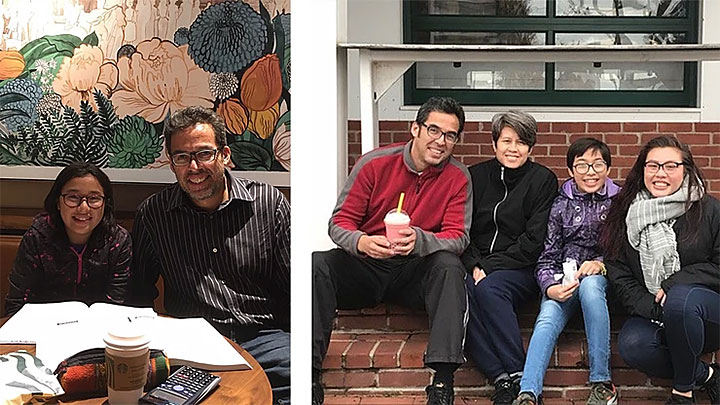
Dr. Camino working with his youngest daughter at a coffee shop on math problems (left). Dr. Camino and his family enjoying a fall day at home (right).
What advice/suggestions would you give to early career scientists in the nanoscience field?
I think that finding good mentors/advisors is a vital component of success in any field. I am very grateful to both my Ph.D. and postdoctoral advisors. They are not only outstanding scientists, but also excellent human beings. The same applies to finding your boss in your first “real” job. I was also extremely lucky in this case. Luck is very helpful, but if you are not lucky, it doesn’t mean that you have to stick with a bad advisor or boss. Switching research groups or jobs in search of a better environment is not a bad thing. There are plenty of excellent scientists who are also excellent people. Any time you devote to searching a good place to work is time very well spent.
LinkedIn: https://www.linkedin.com/in/fernando-camino-5113a313b/
2019-16937 | INT/EXT | Newsroom









